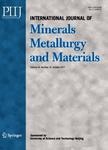Electrochemical corrosion failure mechanism of M152 steel under a salt-spray environment
Electrochemical corrosion failure mechanism of M152 steel under a salt-spray environment作者机构:Corrosion and Protection Center University of Science and Technology Beijing Institute of Advanced Materials and Technology University of Science and Technology Beijing State Key Laboratory for Marine Corrosion and ProtectionLuoyang Ship Material Research Institute Ningbo Institute of Material Technology & Engineering Chinese Academy of Sciences
出 版 物:《International Journal of Minerals,Metallurgy and Materials》 (矿物冶金与材料学报(英文版))
年 卷 期:2015年第22卷第11期
页 面:1183-1189页
核心收录:
学科分类:08[工学] 080502[工学-材料学] 0805[工学-材料科学与工程(可授工学、理学学位)]
主 题:heat resistant steel electrochemical corrosion failure mechanism salt spray test
摘 要:The corrosion failure mechanism of M152 was studied using the neutral salt-spray test to better understand the corrosion behavior of 1Cr12Ni3Mo2VN(M152), provide a basis for the optimization of material selection, and prevent the occurrence of failure. Moreover, the mechanism was investigated using the mass loss method, polarization curves, electrochemical impedance spectroscopy(EIS), stereology microscopy, scanning electron microscopy, and energy-dispersive X-ray spectroscopy(EDS). The results show that M152 steel suffers severe corrosion, especially pitting corrosion, in a high-salt-spray environment. In the early stage of the experiment, the color of the corrosion products was mainly orange. The products then gradually evolved into a dense, brown substance, which coincided with a decrease of corrosion rate. Correspondingly, the EIS spectrum of M152 in the late test also exhibited three time constants and presented Warburg impedance at low frequencies.



